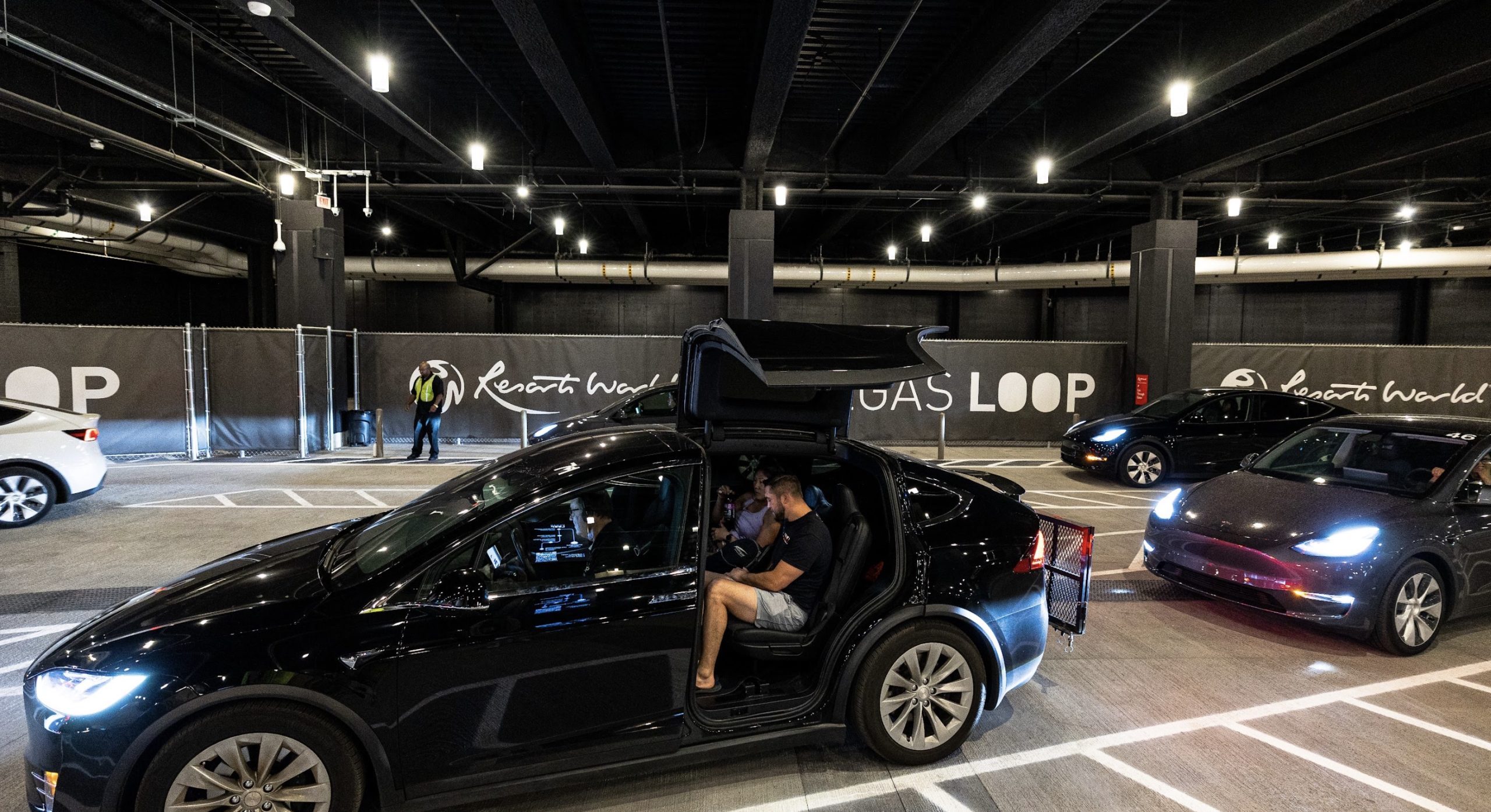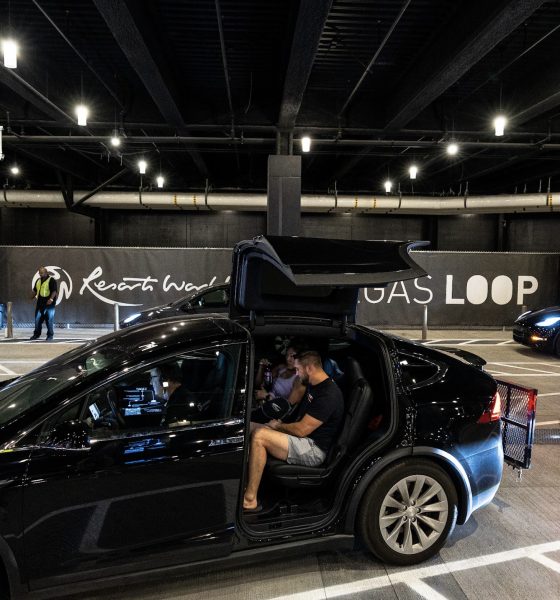

News
Tesla’s self-driving rollout strategy for Boring Co’s Las Vegas Loop gets teased
Steve Hill, president and CEO of the Las Vegas Convention and Visitors Authority (LVCVA), has shared some interesting tidbits about The Boring Company’s plans for the rollout of its self-driving Tesla fleet for its Las Vegas tunnels. Hill noted that while the entire system would likely not be self-driving by the end of this year, tests involving some autonomous cars should begin soon.
Initial renders of The Boring Company’s Loop system showed sleek tunnels with futuristic high-capacity vehicles traveling from one station to another autonomously. Yet for now, the Las Vegas Convention Center Loop and the Resorts World station operate using manually-driven Teslas that can hold about three passengers per vehicle. This has caught some mockery from Elon Musk critics.
Yet according to Hill, Tesla is continuing to work on its full self-driving system for the vehicles in the Las Vegas tunnels. In comments to the Las Vegas Review-Journal, Hill stated that he believes some of the Teslas being used in the Loop system would use the company’s full self-driving system sometime in the next fiscal year.
“We are certainly headed toward an autonomous system. We said at a (LVCVA) board meeting a month or two ago that our goal was, by the end of this fiscal year, to have some amount of autonomous driving happening in the system,” Hill said.
Elon Musk has mentioned recently that the Las Vegas Loop’s Tesla fleet may use FSD later this year. In this light, Hill noted that one vehicle at a time would be switched to use Tesla’s full self-driving system. And even at this point, they will still be using safety drivers until it can be proven that the vehicles can operate safely and adequately on their own. Only at this point will the drivers be removed.
“I don’t think we’ll be fully autonomous by the end of this calendar year, but we think we’re in a position to start testing autonomy relatively soon,” the LVCVA president said.
High-capacity vehicles for the Loop system will also be coming in the future. As it turned out, the advent of the pandemic during the buildout of the Las Vegas Convention Center Loop helped push officials to hold off on high-capacity vehicles. Teslas that carry three people are safer, after all, than a vehicle that carries 12 passengers during a pandemic.
But once the system expands and as FSD is rolled out to the Loop’s fleet, The Boring Company’s high-capacity vehicles are expected to be released. Hill noted that Elon Musk’s “Robovan” could be a good candidate for the Loop system’s high-capacity vehicles. Musk did note that Tesla’s Robovan will be highly configurable, so designing a version of the vehicle for The Boring Company’s Loop system should be no problem.
“You may have seen Elon tweeted out that he is working on a higher capacity vehicle, and it’s able to be modified for different applications. We think something along those lines, a version of that will be a part of this system,” Hill said.
For now, however, Hill told the Review-Journal that the current Tesla fleet deployed on the Las Vegas Convention Center and Vegas Loop is already useful. “You can use those higher-occupancy vehicles when you have a group of people who want to go from one place to the same place. Often folks don’t. The ability to have an individual car for people who want to go someplace different from where everybody else is going is an important aspect in the system. The higher occupancy vehicles will be helpful, too,” he said.
Don’t hesitate to contact us with news tips. Just send a message to simon@teslarati.com to give us a heads up.

News
SpaceX shades airline for seeking contract with Amazon’s Starlink rival

SpaceX employees, including its CEO Elon Musk, shaded American Airlines on social media this past weekend due to the company’s reported talks with Amazon’s Starlink rival, Leo.
Starlink has been adopted by several airlines, including United Airlines, Qatar Airways, Hawaiian Airlines, WestJet, Air France, airBaltic, and others. It has gained notoriety as an extremely solid, dependable, and reliable option for airline travel, as traditional options frequently cause users to lose connection to the internet.
Many airlines have made the switch, while others continue to mull the options available to them. American Airlines is one of them.
A report from Bloomberg indicates the airline is thinking of going with a Starlink rival owned by Amazon, called Leo. It was previously referred to as Project Kuiper.
American CEO Robert Isom said (via Bloomberg):
“While there’s Starlink, there are other low-Earth-orbit satellite opportunities that we can look at. We’re making sure that American is going to have what our customers need.”
Isom also said American has been in touch with Amazon about installing Leo on its aircraft, but he would not reveal the status of any discussions with the company.
The report caught the attention of Michael Nicolls, the Vice President of Starlink Engineering at SpaceX, who said:
“Only fly on airlines with good connectivity… and only one source of good connectivity at the moment…”
CEO Elon Musk replied to Nicolls by stating that American Airlines risks losing “a lot of customers if their connectivity solution fails.”
American Airlines will lose a lot of customers if their connectivity solution fails
— Elon Musk (@elonmusk) December 14, 2025
There are over 8,000 Starlink satellites in orbit currently, offering internet coverage in over 150 countries and territories globally. SpaceX expands its array of satellites nearly every week with launches from California and Florida, aiming to offer internet access to everyone across the globe.
Currently, the company is focusing on expanding into new markets, such as Africa and Asia.
News
Tesla Model Y Standard stuns in new range test, besting its Premium siblings
Tesla’s newer vehicles have continued to meet or exceed their EPA estimates. This is a drastic change, as every 2018-2023 model year Tesla that Edmunds assessed did not meet its range estimates.

The Tesla Model Y Standard stunned in a new range test performed by automotive media outlet Edmunds, besting all of its Premium siblings that are more expensive and more luxurious in terms of features.
Testing showed the Model Y Standard exceeded its EPA-estimated range rating of 321 miles, as Edmunds said it is the “longest-range Model Y that we’ve ever put on our loop.” In the past, some vehicles have come up short in comparison with EPA ranges; for example, the Model Y’s previous generation vehicle had an EPA-estimated range of 330 miles, but only drove 310.
Additionally, the Launch Series Model Y, the first configuration to be built in the “Juniper” program, landed perfectly on the EPA’s range estimates at 327 miles.
It was also more efficient than Premium offerings, as it utilized just 22.8 kWh to go 100 miles. The Launch Series used 26.8 kWh to travel the same distance.
It is tested using Edmunds’ traditional EV range testing procedure, which follows a strict route of 60 percent city and 40 percent highway driving. The average speed throughout the trip is 40 MPH, and the car is required to stay within 5 MPH of all posted speed limits.
Each car is also put in its most efficient drive setting, and the climate is kept on auto at 72 degrees.
“All of this most accurately represents the real-world driving that owners do day to day,” the publication says.
With this procedure, testing is as consistent as it can get. Of course, there are other factors, like temperature and traffic density. However, one thing is important to note: Tesla’s newer vehicles have continued to meet or exceed their EPA estimates. This is a drastic change, as every 2018-2023 model year Tesla that Edmunds assessed did not meet its range estimates.
Tesla Model Y Standard vs. Tesla Model Y Premium
Tesla’s two Model Y levels both offer a great option for whichever fits your budget. However, when you sit in both cars, you will notice distinct differences between them.
The Premium definitely has a more luxurious feel, while the Standard is stripped of many of the more premium features, like Vegan Leather Interior, acoustic-lined glass, and a better sound system.
You can read our full review of the Model Y Standard below:
Tesla Model Y Standard Full Review: Is it worth the lower price?
News
Xpeng CEO: Tesla FSD 14.2 has developed “near-Level 4” performance
While acknowledging that imperfections remain, the Xpeng CEO said FSD’s current iteration significantly surpasses last year’s capabilities.

Xpeng CEO He Xiaopeng has offered fresh praise for Tesla’s Full Self-Driving (FSD) system after revisiting Silicon Valley more than a year after his first hands-on experience.
Following extended test drives of Tesla vehicles running the latest FSD software, He stated that the system has made major strides, reinforcing his view that Tesla’s approach to autonomy is indeed the proper path towards autonomy.
Tesla FSD closing in on Level 4 driving
During his visit, He test-drove a Tesla equipped with FSD V14.2. He also rode in a Tesla Robotaxi. Over roughly five hours of driving across Silicon Valley and San Francisco, He said both vehicles delivered consistent and reassuring performance, a notable improvement from his experience a year earlier.
According to He, Tesla’s FSD has evolved from a smooth Level 2 advanced driver assistance system into what he described as a “near-Level 4” experience in terms of capabilities. While acknowledging that imperfections remain, the Xpeng CEO said FSD’s current iteration significantly surpasses last year’s capabilities. He also reiterated his belief that Tesla’s strategy of using the same autonomous software and hardware architecture across private vehicles and robotaxis is the right long-term approach, allowing users to bypass intermediate autonomy stages and move closer to Level 4 functionality.
He previously tested Tesla’s FSD V12.3.6 and Waymo vehicles in California in mid-2024, noting at the time that Waymo performed better in dense urban environments like San Francisco, while Tesla excelled in Silicon Valley and on highways.
Xpeng’s ambitious autonomy roadmap and internal challenge
The Silicon Valley visit also served as a benchmark for Xpeng’s own autonomy ambitions. He stated that Xpeng is looking to improve its VLA autonomous driving system to match the performance of Tesla’s FSD V14.2 within China by August 30, 2026. Xpeng is poised to release its VLA 2.0 smart driving software next quarter, though He cautioned that the initial version will not be able to match FSD V14.2’s capabilities, as noted in a CNEV Post report.
He also added a personal twist to the goal, publicly challenging Xpeng’s autonomous driving team. If the performance target is met by the 2026 deadline, the CEO stated that he will approve the creation of a Chinese-style cafeteria for Xpeng’s Silicon Valley team. If not, Liu Xianming, head of Xpeng’s autonomous driving unit, has pledged to run naked across the Golden Gate Bridge, He noted.








